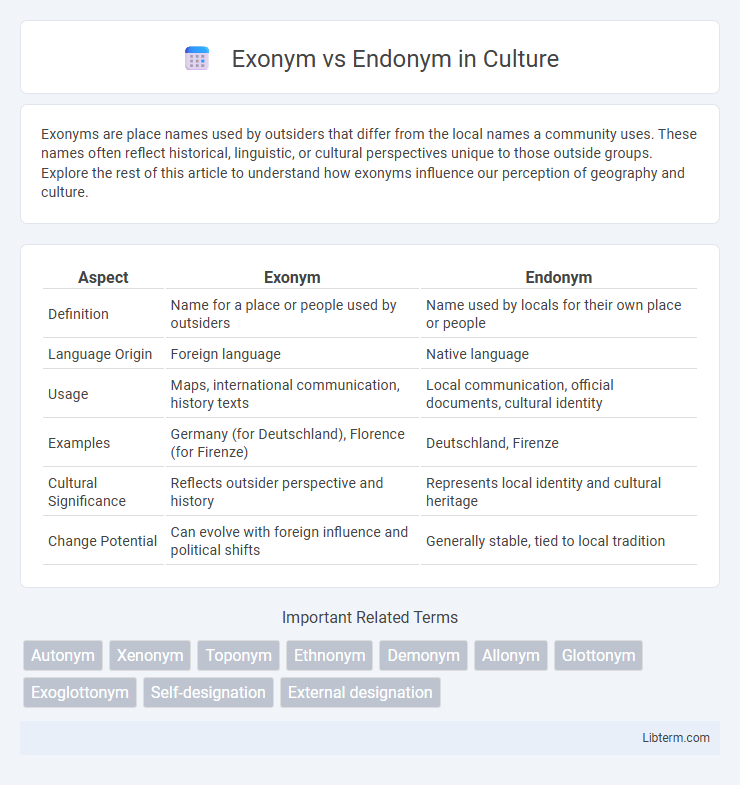Exonyms are place names used by outsiders that differ from the local names a community uses. These names often reflect historical, linguistic, or cultural perspectives unique to those outside groups. Explore the rest of this article to understand how exonyms influence our perception of geography and culture.
Table of Comparison
| Aspect | Exonym | Endonym |
|---|---|---|
| Definition | Name for a place or people used by outsiders | Name used by locals for their own place or people |
| Language Origin | Foreign language | Native language |
| Usage | Maps, international communication, history texts | Local communication, official documents, cultural identity |
| Examples | Germany (for Deutschland), Florence (for Firenze) | Deutschland, Firenze |
| Cultural Significance | Reflects outsider perspective and history | Represents local identity and cultural heritage |
| Change Potential | Can evolve with foreign influence and political shifts | Generally stable, tied to local tradition |
Introduction to Exonyms and Endonyms
Exonyms and endonyms are terms used to describe geographical names from different linguistic perspectives. An exonym is a name for a place that is used by outsiders, such as "Germany" for the country known as "Deutschland" by its residents, who use the endonym. Understanding the distinction between exonyms and endonyms is crucial for accurate cultural representation, cartography, and international communication.
Definition of Exonym
An exonym is a place name or geographic term used by outsiders that differs from the name used by the local population, known as the endonym. Exonyms often arise due to language differences, historical influences, or cultural perceptions and can reflect external interpretations of a location. Common examples include "Germany" as an exonym for the German endonym "Deutschland" and "Florence" for the Italian "Firenze.
Definition of Endonym
An endonym is the name for a geographical place, site, or location used by the local inhabitants or native speakers of that area. It reflects the linguistic, cultural, and historical identity embedded within the community, often differing significantly from foreign or external names known as exonyms. Understanding endonyms is essential for accurate representation in maps, international relations, and cultural studies.
Historical Origins of Exonyms and Endonyms
Exonyms and endonyms originate from the historical interactions between different cultures and languages, where exonyms are place names given by outsiders, and endonyms are the names used by native inhabitants. The development of exonyms often reflects historical trade routes, conquests, colonization, and linguistic adaptations, highlighting shifts in political power and cultural influence. Endonyms preserve indigenous identity and heritage, representing the original linguistic and cultural context of a geographic location.
Why Exonyms Exist: Motivations and Examples
Exonyms exist due to historical contact, linguistic differences, and cultural perspectives, serving as names outsiders assign to places or peoples, often to simplify pronunciation or reflect historical relationships. For example, "Germany" is an exonym derived from Latin "Germania," whereas the endonym is "Deutschland," reflecting the native German-speaking population. Such distinctions arise from trade, colonization, and geopolitical influences that shape how regions and cultures are referenced globally.
Cultural Sensitivity and Identity in Naming
Exonyms and endonyms reflect differing cultural perspectives, where endonyms represent the indigenous or local names used by a community to assert identity and heritage. Respecting endonyms fosters cultural sensitivity by acknowledging the significance of self-identification and reducing colonial or external impositions inherent in exonyms. The choice between exonym and endonym affects geopolitics, social cohesion, and the preservation of linguistic diversity across global regions.
Linguistic Impacts of Using Exonyms vs Endonyms
Using exonyms often reflects historical, cultural, and political perspectives of the naming group, which can lead to linguistic distortions or misinterpretations of the original place names and their meanings. Endonyms preserve the native linguistic identity and cultural heritage by maintaining the authentic pronunciation and semantics as used by the local population. The linguistic impact includes the reinforcement of local identity and respect for indigenous languages, while exonyms may contribute to language dominance and potential erasure of minority linguistic heritages.
Contemporary Shifts Toward Endonym Usage
Contemporary shifts toward endonym usage reflect a growing emphasis on cultural respect and self-identification by indigenous and local communities worldwide. Endonyms, the native names for places and peoples, challenge exonyms, which are external names often rooted in colonial or outsider perspectives, fostering greater accuracy and inclusivity in global discourse. This trend influences international policies, cartography, and media representation, promoting linguistic authenticity and decolonization efforts.
Exonym-Endonym Case Studies Around the World
Exonym and endonym distinctions reveal diverse linguistic and cultural identities in place names worldwide, such as Germany's endonym "Deutschland" contrasted with the English exonym "Germany." Case studies include Istanbul, historically known by the exonym "Constantinople," demonstrating shifts in geopolitical influence and language usage. Similarly, the Maori endonym for New Zealand, "Aotearoa," highlights indigenous recognition often overshadowed by its widely used exonym.
Conclusion: The Importance of Respectful Place-Naming
Respectful place-naming acknowledges both exonyms and endonyms, reflecting cultural identity and historical context while promoting mutual understanding. Prioritizing endonyms supports linguistic diversity and respects the self-identification of local communities. Incorporating both naming conventions fosters global communication without erasing the significance of native heritage.
Exonym Infographic

 libterm.com
libterm.com